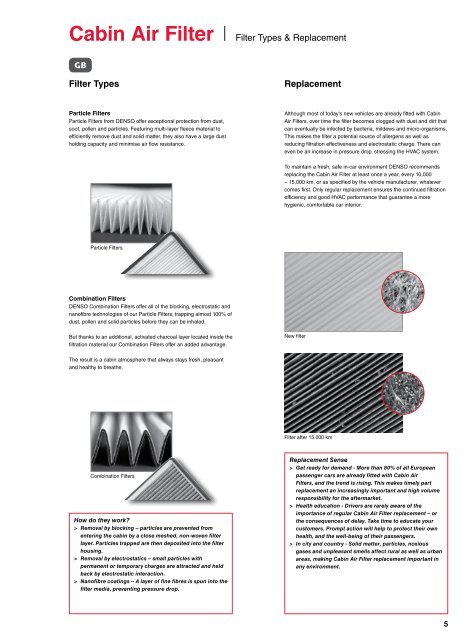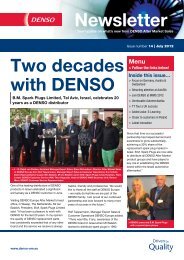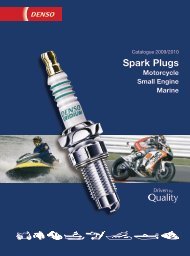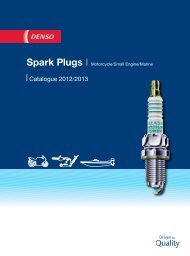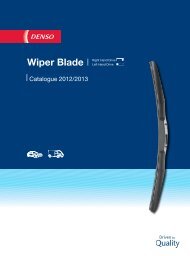Cabin Air Filter - Denso-am.eu
Cabin Air Filter - Denso-am.eu
Cabin Air Filter - Denso-am.eu
Create successful ePaper yourself
Turn your PDF publications into a flip-book with our unique Google optimized e-Paper software.
<strong>Cabin</strong> <strong>Air</strong> <strong>Filter</strong> <strong>Filter</strong> Types & Replacement<br />
GB<br />
<strong>Filter</strong> Types Replacement<br />
Particle <strong>Filter</strong>s<br />
Particle <strong>Filter</strong>s from DENSO offer exceptional protection from dust,<br />
soot, pollen and particles. Featuring multi-layer fleece material to<br />
efficiently remove dust and solid matter, they also have a large dust<br />
holding capacity and minimise air flow resistance.<br />
Particle <strong>Filter</strong>s<br />
Combination <strong>Filter</strong>s<br />
DENSO Combination <strong>Filter</strong>s offer all of the blocking, electrostatic and<br />
nanofibre technologies of our Particle <strong>Filter</strong>s; trapping almost 100% of<br />
dust, pollen and solid particles before they can be inhaled.<br />
But thanks to an additional, activated charcoal layer located inside the<br />
filtration material our Combination <strong>Filter</strong>s offer an added advantage.<br />
The result is a cabin atmosphere that always stays fresh, pleasant<br />
and healthy to breathe.<br />
Combination <strong>Filter</strong>s<br />
How do they work?<br />
> Removal by blocking – particles are prevented from<br />
entering the cabin by a close meshed, non-woven filter<br />
layer. Particles trapped are then deposited into the filter<br />
housing.<br />
> Removal by electrostatics – small particles with<br />
permanent or temporary charges are attracted and held<br />
back by electrostatic interaction.<br />
> Nanofibre coatings – A layer of fine fibres is spun into the<br />
filter media, preventing pressure drop.<br />
Although most of today’s new vehicles are already fitted with <strong>Cabin</strong><br />
<strong>Air</strong> <strong>Filter</strong>s, over time the filter becomes clogged with dust and dirt that<br />
can eventually be infected by bacteria, mildews and micro-organisms.<br />
This makes the filter a potential source of allergens as well as<br />
reducing filtration effectiveness and electrostatic charge. There can<br />
even be an increase in pressure drop, stressing the HVAC system.<br />
To maintain a fresh, safe in-car environment DENSO recommends<br />
replacing the <strong>Cabin</strong> <strong>Air</strong> <strong>Filter</strong> at least once a year, every 10,000<br />
– 15,000 km, or as specified by the vehicle manufacturer, whatever<br />
comes first. Only regular replacement ensures the continued filtration<br />
efficiency and good HVAC performance that guarantee a more<br />
hygienic, comfortable car interior.<br />
New filter<br />
<strong>Filter</strong> after 15.000 km<br />
Replacement Sense<br />
> Get ready for demand - More than 80% of all European<br />
passenger cars are already fitted with <strong>Cabin</strong> <strong>Air</strong><br />
<strong>Filter</strong>s, and the trend is rising. This makes timely part<br />
replacement an increasingly important and high volume<br />
responsibility for the aftermarket.<br />
> Health education - Drivers are rarely aware of the<br />
importance of regular <strong>Cabin</strong> <strong>Air</strong> <strong>Filter</strong> replacement – or<br />
the consequences of delay. Take time to educate your<br />
customers. Prompt action will help to protect their own<br />
health, and the well-being of their passengers.<br />
> In city and country - Solid matter, particles, noxious<br />
gases and unpleasant smells affect rural as well as urban<br />
areas, making <strong>Cabin</strong> <strong>Air</strong> <strong>Filter</strong> replacement important in<br />
any environment.<br />
5


